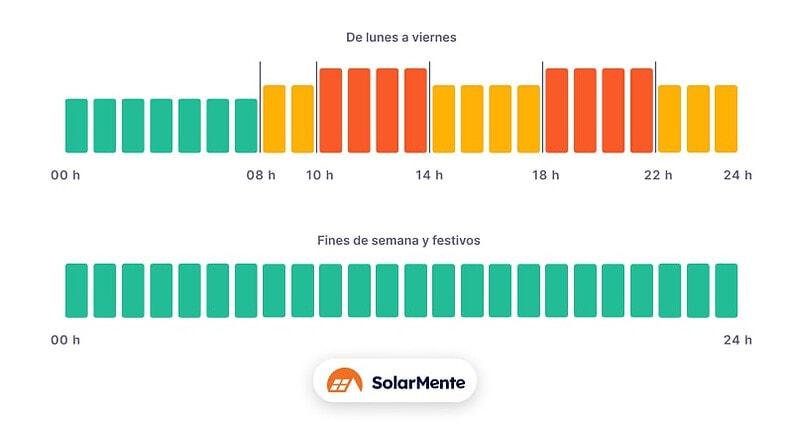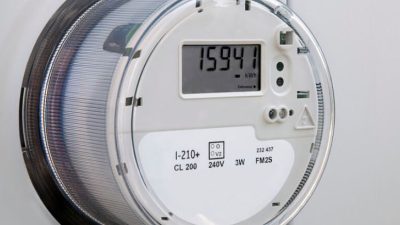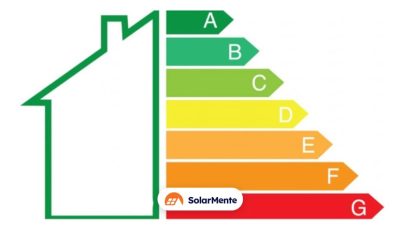One of the most dreaded moments at the end of the month is checking the electricity bill.
And no matter how hard we try to understand the information, we don’t know if the best option is to opt for the tariff with hourly discrimination.
In what situations is it profitable to use it?
In this article we explain what the new time discriminating tariff consists of, how to find out if it is the right model for you and its involvement with a self-consumption system.
In addition, we will give you some tips on how to further reduce your electricity costs month by month.
Let’s get started!
What is time discriminating?
Time discrimination, also known as night-time tariffs, is a type of electricity tariff that establishes different energy prices depending on the time of day and the season, i.e. whether it is summer or winter.
In this line, there are two models:
-
Old time zone differentiation. It contemplates two and three bands with different prices, valley and peak. Only suitable for the free market.
-
New hourly discrimination. It includes three prices for energy (valley, flat and peak) and can be accessed both in the free and regulated market.
The aim is to reduce expenditure in time slots with a higher energy demand.
The old tariff with hourly discrimination
Electricity tariffs were modified as of 1 June 2021.
But before the regulatory change, we had the possibility to choose between a total of 6 tariffs:
-
2.0A without time discrimination
-
2.0DHA with 2 discrimination periods
-
2.0DHS with 3 discrimination periods
-
2.1A without discrimination
-
2.1DHA with 2 periods
-
2.1DHS with 3 periods
DHS tariffs had no seasonal variation.
Time discriminating with 2 periods
In the old time discriminating tariffs, there were tariffs with 2 different periods:
-
Peak hour: in winter the established hours were between 12h and 22h, while in summer they were from 13h to 23h.
-
Off-peak hour. In winter, this includes the hours between 22h and 12h, and in summer, the interval from 23h to 13h.
Hourly discrimination with 3 periods
In the same way as the new hourly discrimination, this tariff is divided into 3 periods that change their amount according to the season:
-
Peak hour:
-
Winter: the interval of hours between 12h and 22h.
-
Summer: between 13:00h and 23:00h.
-
-
Off-peak hour:
-
Winter: between 22h and 12h.
-
Summer: between 23h and 13h.
-
-
Off-peak time: between 01h and 7h.
The new time discrimination with 3 periods
The change of tariff contemplates the following periods:
-
Peak hour: between 10am – 2pm and 6pm – 10pm.
-
Flat hour: between 8am – 10am; 2pm – 6pm, Monday to Friday.
-
Off-peak hour: between 00h and 08h, Saturdays and Sundays.
This is the only time discrimination, but it does not mean that the price differs according to the hour and time of day.
And we tell you why.
People who were on the Regulated Market perceived an automatic changeover to this new modality.
That is to say, those households that opted for a market price that changes every hour and day have not had the possibility to choose. The change is immediate.
To find out how much you are paying at any given moment, you can check it on the internet. All you have to do is add “consult the price of electricity per hour” in your search engine and you will have access to the information.
But in homes with a fixed price, i.e. the free market, it works differently.
In fact, they had the possibility to keep this structure or switch to the tariff with hourly discrimination.
Beyond that, the change of tariffs brought with it a change of power divided into two periods:
-
Peak hour. From 8h to 24h from Monday to Friday.
-
Off-peak hour. From 24h to 8h from Monday to Friday and all weekends and holidays.
When is the hourly tariff profitable?
Well, if you are in the free market and you are not sure whether or not to keep the fixed prices, and if the change to the tariff with hourly discrimination is for you, we will tell you when it is convenient.
This type of tariff is profitable if you are able to transfer at least 30% of your consumption to the most economical hours, i.e., valley or flat.
Think about it.
The refrigerator alone has an electricity consumption of 22.4%, one of the appliances that consume the most in the home simply because it is connected 24 hours a day. Therefore, with discrimination you can take advantage of the intervals of flat hours and valleys, where the price of electricity is cheaper.
Who else can benefit from this tariff?
The TDH is also beneficial for people who work at home and can shift consumption to the cheapest hours, for example, the washing machine or dishwasher.
For this reason, it is important to know our consumption habits and lifestyle. If we can adapt them to these time slots, go ahead. You will notice a significant reduction in electricity costs.
Tips on how to save with the new time discriminating tariff
The important thing is to shift as much consumption as possible to off-peak hours or, where appropriate, to flat hours.
How to save with time discriminating tariffs?
Take a pen and paper, and write down these tips we are going to give you:
-
Program the dishwasher and washing machine in the cheapest periods, either at night or during off-peak hours. If you do not have the programming function, you can buy a timer. They cost around 15-20 euros.
-
Use the off-peak hours of the weekend to prepare the week’s meals. Not only do you save energy, but you also have more free time to do what you want to do.
-
If you have a cleaning robot or cordless hoover with you, charge them during off-peak hours, as well as any other electronic devices.
Is time discrimination profitable for self-consumption?
If you are thinking of installing a solar panel system in your home, the time discriminating tariff is a privilege for you.
The reason is that the highest production of an installation takes place during daylight hours, when sunlight is present and when electricity prices are highest.
Therefore, during this time, we dispense with the use of the traditional electricity grid to self-consume our own energy.
And the positive aspect of all this is that, with this tariff, the price per kWh consumed at night, when there is no electricity, is considerably lower compared to the price established during peak hours.
This is if the photovoltaic system is connected to the electricity grid. However, if you decide to install batteries, you will not be covered by this tariff, but the savings will be greater and the surplus energy can be stored for the night hours.
Whether you want to switch to self-consumption with or without batteries, this is the way to go.
So, can I save with time discriminating tariffs?
There is no single answer, it depends on the individual’s habits.
If you will be able to shift at least 30% of your consumption to the most economical hours, then you will achieve significant savings.
In this article we have explained some tips on how to save with the time discriminating tariff, but how you can really save on electricity is with a self-consumption installation for your home.
During daylight hours, you take advantage of your system and only have to use the grid when there is no electricity.
And this means that your savings can reach at least 50% of the electricity tariff.
How do I know how much I can save every month?
We know it’s not an easy task and that’s why we have a self-consumption calculator for you to find out how much you can save month by month.
It will only take you 1 minute.
See you inside?
Frequently asked questions
How do I know if I have an hourly rate?
It’s very simple. All you have to do is check your electricity tariff and see if it shows PVPC (regulated market) or free market.
You will be in the regulated market, if any of the last resort marketers listed below are included:
-
Baser
-
Energy XXI (Endesa)
-
Regulated Marketer Naturgy Group
-
Last Resort Reseller of the Iberdrola Group
Remember that this tariff changes according to the time and day.
















